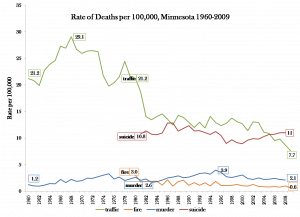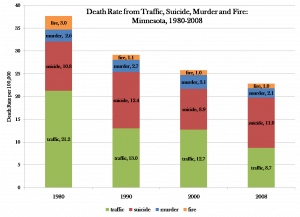When the Strib reported that Minnesota traffic deaths had fallen to a 65-year low, I checked the Department of Public Safety to see the long-term trend. They posted data from 1910 to present on traffic fatalities and from 1961 to present on vehicle miles traveled. The rate of deaths per mile traveled has fallen even more sharply than the rate per 100,000 population. As the figure shows below, both peak in the beautiful-but-deadly muscle car era of the late 1960s. Experts attribute the drop to safety features such as seat belts and airbags. Why, my own dad tells me that he started buckling up his seat belt when the legislature toughened the mandatory seat belt in 2009 — he even stuck a post-it note on the steering wheel to remind him of the fine.
Over the past three decades, the death rate has also fallen for homicide and fire in Minnesota. In contrast, the suicide rate has risen in recent years. In 2008, almost as many Minnesotans died from suicide as from fire, traffic, and homicide combined. The final numbers are not yet available for 2009, but I bet that the number of suicides now surpasses the combined sum of the other three categories. Moreover, at least some of the deaths classified as accidental fires, car crashes, and shootings may be victim-precipitated (e.g., one-car accidents, “suicide by cop”).
Suicide rates rise with age, especially for white males, so the number of suicides is likely to rise in Minnesota as the population ages (the figures above are not age-adjusted). Nevertheless, the overall death rate across the four categories has fallen from about 38/100k in 1980 to about 23/100k in 2008. If these trends continue, I suspect that more social scientists will be turning their attention to suicide (and, presumably, Durkheim) in coming years.


 [
[
Comments 1
sidd — June 17, 2019
I really like this text twist 3 great article thanks for this.